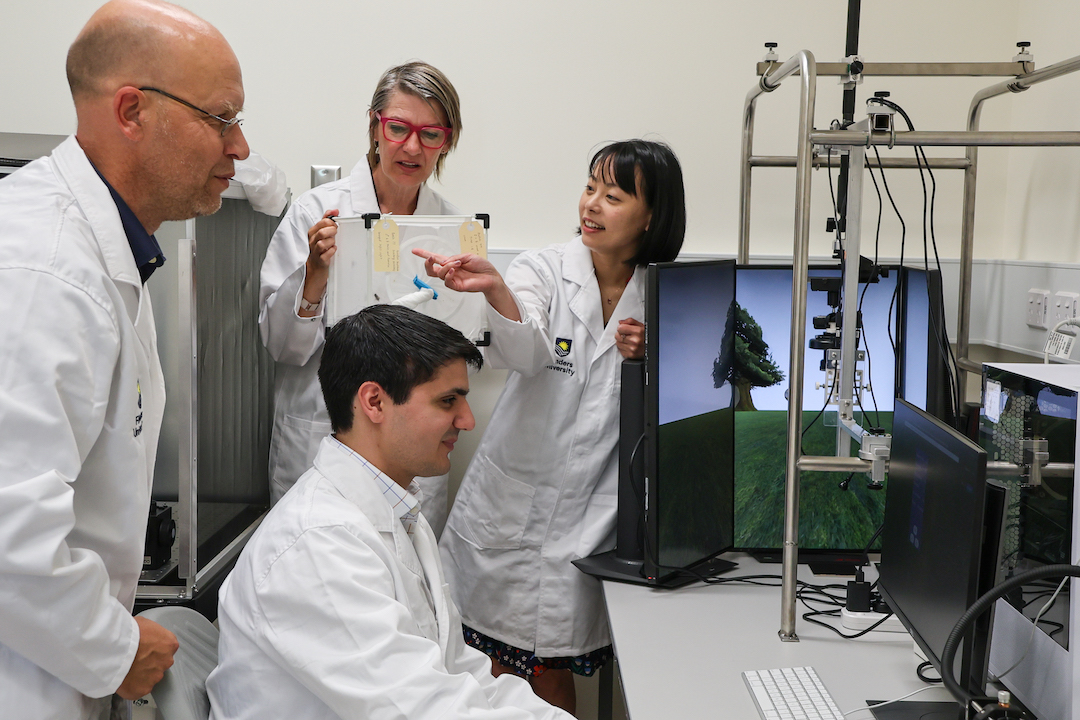Scientists have used virtual reality gaming to test the reactions of insects, with surprising results.
A team led by Flinders University has employed virtual reality and advanced entertainment technology to study the aerodynamic patterns of flying insects. The aim is to better understand behavioural trends in native insect species by changing aspects of the environment in a lab-controlled setting and monitoring results.

Depiction of a hoverfly in the field © Flinders University
Why study insects?
According to the Australian Museum, insects are the largest group of animals on Earth, making up 75 percent of all catalogued species. Insects are categorised by an exoskeleton and three body parts; head, thorax and abdomen. They also have six limbs and a pair of antennae.
Insects are a vital part of every ecosystem. They play a major role in the process of pollination, and act as a food source for larger fauna.
Studying Australian insects can provide insight into how ecosystems grow and change, as well as the food webs that exist within these environments.

Dr Richard Leibbrandt, Professor Nordström and Flinders University colleagues Raymond Aoukar and Dr Yuri Ogawa demonstrate the new program © Flinders University
Simulated situations
The paper, published in Methods of Ecology and Evolution, details new gaming software developed by the Flinders University team in the Hoverfly Motion Vision Lab.
Developed by a team of biologists, neuroscientists and software experts, the program allows rigorous testing of aviation and precision devices intended to unpack the highly compressed and enhanced visual system of hoverflies and other insects.
According to Dr Yuri Ogawa, Research Fellow in Neuroscience at the Flinders Health and Medical Research Institute, “we developed computer programs that create a virtual reality experience for the animals to move through.”
“Using machine learning and computer vision algorithms, we were able to observe the animals and work out what they are doing, whether that is a hoverfly attempting to turn to the left in its flight, or a fiddler crab avoiding a virtual bird flying overhead.
“The software then adapts the visual scenery to match the movements that the animal has made.”

Facts and findings
Virtual reality is already being used to revolutionise a wide variety of industries including agriculture, where automatically monitoring crops and livestock is enabled by robots.
Using this virtual world should allow for further study into animal behaviour, resulting in greater detail and understanding about the way insects interact with the world.
“The last two decades have seen very rapid advances in algorithms and computer technology, such as virtual reality, gaming, artificial intelligence, and high-speed calculation using specialised computer hardware in graphics cards,” says Mr Aoukar, a Flinders University computer science graduate.
“These technologies are now mature and accessible enough to run on consumer computer equipment, which opens up the chance to study animal behaviour in an environment that is systematically controlled, but still more natural than a typical lab experiment.”
The recent study has also supported the development of tools identifying visual triggers of behaviour.
Other research groups are already taking interest in the software, which can be downloaded from the journal article.
“This has truly been a team effort where every author on the paper has been instrumental in making the VR work. We look forward to using the VR to investigate the mechanisms underlying decision-making in insects,” says Professor Nordström.
Interested in more scientific studies? To read about how personality traits in greylag geese can impact breeding success, click here.

